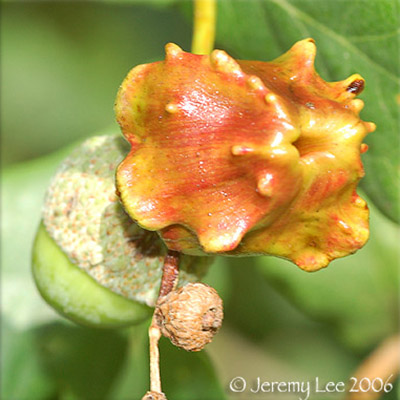
 |
|
Scientific Classifications explained » Amphibians » Ants » Aphids » Bees » Beetles » Birds » Bugs » Butterflies » Caterpillars » Damselflies » Dragonflies » Earwigs » Flies » Frog/Leafhoppers » Fungi » Galls » Grasshoppers » Harvestmen » Hoverflies » Lacewings » Ladybirds » Leaf Mines » Lichens » Mammals » Millipedes » Mosses » Moths » Sawflies » Slugs » Snails » Spiders » Trees » Wasps » Wild Flowers » Woodlice |
UK Nature > Galls > Oak Knopper Gall

Gall causer: Andricus quercuscalicis Common Name: Oak Knopper Gall Knopper galls on our traditional English oak, Quercus robur, are caused by a minute gall wasp, Andricus quercuscalicis. The insect is a relative newcomer to Britain, the first recorded sighting being in 1962. It appears to have arrived naturally from the continent and rapidly spread across England and Wales. In 1979 it underwent a population explosion and for a time there was real concern that it would seriously affect the acorn fertility and thus the future of our most iconic tree. Like most gall wasps, the life cycle is complicated, with an alternation of a sexual and asexual generation each year. Only females emerge from the knopper galls and these lay their eggs in the buds of the Turkey Oak, Quercus cerris. In the spring this sexual generation causes minute galls in the male catkins. And why "knopper" gall? The Oxford English Dictionary defines a 'knop' as "a small rounded protuberance, boss, stud, button, tassel or the like". |
|

https://www.uknature.co.uk is a website dedicated to showing the immense diversity of UK nature and wildlife. Our vast range of habitats, from lowland arable to snow covered mountains, from storm-ravaged coastlines to peaceful inland freshwater lakes and rivers, from dry, sandy heaths to deciduous and coniferous forests, all these habitats contribute to the abundance of UK nature. We have wild birds in huge numbers either residing or visiting our shores (597 recorded species as at July 2013) and we must also not forget the humble back garden with its grass lawns, flower beds filled with nectar rich flowers, shrubs and trees, all designed to attract huge numbers of insects such as bees, moths, butterflies and hoverflies; and finally the small ponds which provide safe havens for frogs, toads, newts and even slow worms and grass snakes. www.uknature.co.uk is the showcase for my personal passion, photographing uknature in all its glory. I sincerely hope you all enjoy the fruits of my labours. This site and all images contained therein is © Jeremy Lee 2004 - 2021. All Rights Reserved. Site design by Jeremy Lee. Site development & IT Support by Stuart Lee. |